
The Lacertidae are the family of the wall lizards, true lizards, or sometimes simply lacertas, which are native to Afro-Eurasia. It is a diverse family with at about 360 species in 39 genera. They represent the dominant group of reptiles found in Europe.

The Gempylidae are a family of perciform fishes commonly known as snake mackerels or escolars. The family includes about 25 species.

Crestfishes, family Lophotidae, are lampriform fishes found in most oceans. It consists of two extant and four extinct genera.

The moonfish of the genus Mene, the sole extant genus of the family Menidae, are disk-shaped fish which bear a vague resemblance to gourami, thanks to their thread-like pelvic fins. Today, the genus is represented only by Mene maculata of the Indo-Pacific, where it is a popular food fish, especially in the Philippines, where it is known as bilong-bilong, chabita, hiwas or tahas.
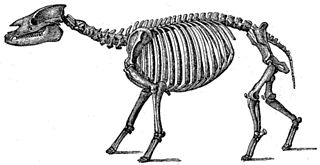
Palaeotheriidae is an extinct family of herbivorous perissodactyl mammals that inhabited Europe, with less abundant remains also known from Asia, from the mid-Eocene to the early Oligocene. They are classified in Equoidea, along with the living family Equidae.

Zignoichthys oblongus is an extinct prehistoric relative of the pufferfish and porcupine fish that lived during the Lutetian epoch of the Eocene. Z. oblongus' fossils are found from the Monte Bolca lagerstätte of what is now Italy.
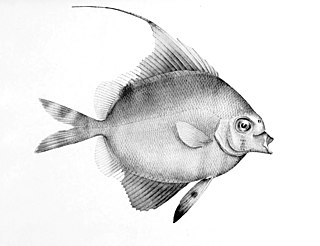
Sailfin moonfishes are a small family, Veliferidae, of lampriform fishes found in the Indian and western Pacific Oceans. Unlike other lampriforms, they live in shallow, coastal waters, of less than 100 m (330 ft) depth, rather than in the deep ocean. They are also much smaller than most of their relatives, up to 30 cm (12 in) in length, and have deep, rather than elongated, bodies. They are characterised by their ability to retract the anterior rays of their dorsal and anal fins into a sheath.

Scomber is a genus of fish in the family Scombridae living in the open ocean found in Atlantic, Indian and Pacific Ocean. The genus Scomber and the genus Rastrelliger comprise the tribe Scombrini, known as the "true mackerels". These fishes have an elongated body, highly streamlined, muscular and agile. The eyes are large, the head is elongated, with a big mouth provided with teeth. They have two dorsal triangular fins, with some stabilizing fins along the caudal peduncle. The basic color is blue-green with a silvery white belly and a darker back, usually black mottled.
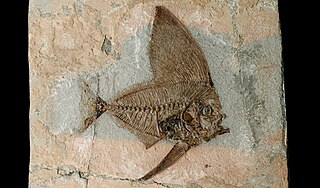
Exellia is a genus of extinct spadefish that lived in the Tethys Ocean during the early Paleogene. The adult form is shaped akin to a large spadefish or a short dolphinfish, with very large pelvic fins, and a long dorsal fin starting from in front of the eyes to near the base of the caudal peduncle. The juvenile form resembles a juvenile drumfish, with the dorsal fin forming a long crest on top of the head.

Avitoluvarus is a genus of extinct louvar that lived in the Tethys Ocean during the early Paleogene. The first specimens were found from the Danata Formation Lagerstätten, of the Thanetian age of Turkmenistan, where they were originally thought to be smaller or juvenile individuals of the true louvar, Luvarus necopinatus. These specimens were later reexamined, and determined to be a separate genus comprising two species.
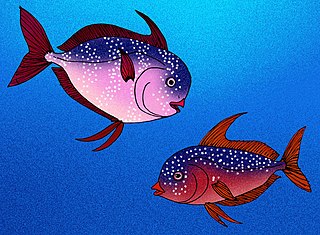
Turkmenidae is an extinct family of lamprids from the Paleogene of Turkmenistan. They were small, disk-shaped fish that bore a strong resemblance to their closest living relatives, the opahs.

Caranx is a genus of tropical to subtropical marine fishes in the jack family Carangidae, commonly known as jacks, trevallies and kingfishes. They are moderate- to large-sized, deep-bodied fishes which are distinguished from other carangid genera by specific gill raker, fin ray and dentition characteristics. The genus is represented in the Pacific, Indian and Atlantic Oceans, inhabiting both inshore and offshore regions, ranging from estuaries and bays to deep reefs and offshore islands. All species are powerful predators, taking a variety of fish, crustaceans and cephalopods, while they in turn are prey to larger pelagic fishes and sharks. A number of fish in the genus have a reputation as powerful gamefish and are highly sought by anglers. They often make up high amounts of the catch in various fisheries, but are generally considered poor to fair table fishes.
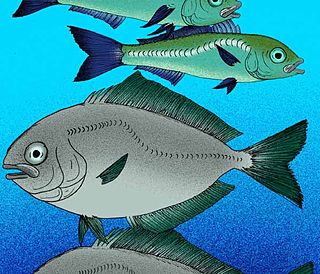
Trachicaranx tersus is an extinct primitive, pompano-like jack fish from what is now Turkmenistan. It lived in an ocean upwelling with its relative, Archaeus oblongus during the Thanetian epoch of the late Paleocene. Some incomplete fossil specimens were once identified as being a separate species, "Uylyaichthys eugeniae."
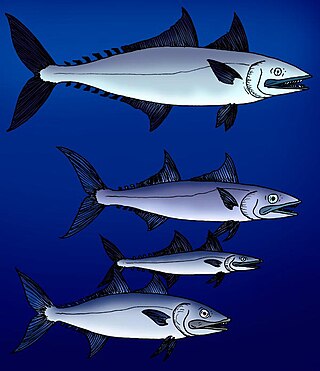
Euzaphlegidae is a family of extinct escolar-like fish closely related to the snake mackerels. Fossils of euzaphlegids are found from Paleocene to Late Miocene-aged marine strata of Europe, the Caucasus Mountains, India, Iran, Turkmenistan, Italy, and Southern California.
Oligolophotes is an extinct genus of fish from the Early Oligocene of the bank of Belaya River in Adygea, the Caucasus Mountains. There is one species, Oligolophotes fragosus, known from the holotype that is estimated to have measured 122 mm (4.8 in) in body length.
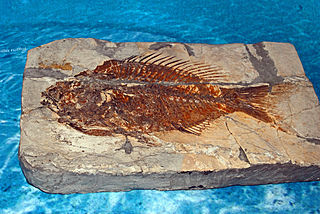
Sparnodus is an extinct genus of prehistoric perciform fish in the family Sparidae. Species of this genus were nektonic carnivores. These fishes lived in the Cenozoic Era, in the Oligocene and Paleocene.

Isurichthys is an extinct genus of prehistoric ray-finned fish, belonging to the family Ariommatidae.

Palimphyes is an extinct genus of prehistoric euzaphlegid bony fish related to the escolars and snake mackerels. The various species lived as deepwater mesopelagic predators in the Tethys and Paratethys oceans, with fossils of ten species found in Paleocene to Oligocene strata of the Swiss Alps, the Carpathian and Caucasus Mountains, Iran, India, and Turkmenistan.
Caucasichthys is an extinct genus of perciform bony fish which existed in Russia during the middle Eocene epoch. It is known from the Gorny Luch locality of northern Caucasus. It was first named by Alexandre F. Bannikov, Giorgio Carnevale and N. V. Parin in 2011 and the type species is Caucasichthys kumaensis. The generic name comes from Caucas, from Caucasus and ichthys, fish. The specific name is derived from the Kuma Horizon, where the fossils were found.
This list of fossil fishes described in 2020 is a list of new taxa of jawless vertebrates, placoderms, acanthodians, fossil cartilaginous fishes, bony fishes, and other fishes of every kind that were described during the year 2020, as well as other significant discoveries and events related to paleoichthyology that occurred in 2020.


















